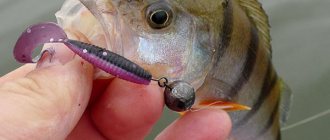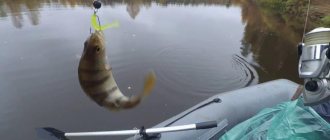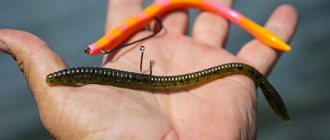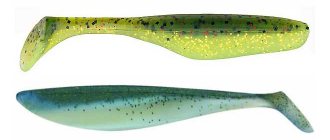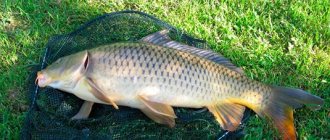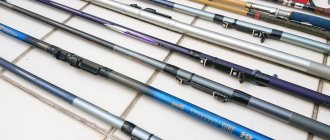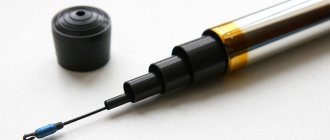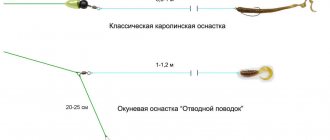Even today, the vibrotail is one of the most competitive baits, allowing you to successfully catch all types of freshwater predatory fish. But as in any important matter, the result of which depends on the implementation of many successive effective operations that collectively bring overall success, and fishing is just such a variant, fishing with a vibrating tail has a number of nuances.
It is about one of these nuances, and in particular how to install a vibrating tail, that we will talk today and try to analyze the main points of its competent execution.
How to properly attach a vibrotail
Silicone jig baits are varied in their shapes and types, and also differ in size and density of the material. All these factors should be taken into account during installation. It’s simply unreasonable to put a silicone bait on a hook, throw it into the water and expect a successful bite. First of all, the fisherman must understand that a vibrating tail can be equipped with different types of hooks: single, offset, double, tee, and this depends on the fishing conditions, the intensity of bites and the type of fish that the fisherman is counting on. The easiest way to attach a vibrating tail is to a jig head.
Important! Select the place where the wide back of the vibrotail transitions into its narrow tail. This transition point should be the point where the hook tip exits the body of the bait.
We pierce the vibrating tail with a sting at the location of the mouth of the artificial fish and string its body until the sting of the hook reaches the point of exit to the surface that we have chosen. We bring the point in the back of the artificial fish to half the roundness of the hook of the jig head. This completes the installation.
Important! The hook of the jig head must correspond to the size of the vibrating tail from the mouth of the fish to the point where the tip of the hook is brought to the surface of the back of the nozzle.
How to select the weight of the jig head at the fishing spot
Initially, you should select a jig head based on a combination of three factors:
- hook size;
- head mass;
- the size of the bait.
Let me explain that large silicone will require a long forend, but not always a large weight of the head load, because this factor depends on the fishing conditions and the depth of the reservoir.
There are several general rules for selecting jig heads by weight:
- The weight of the head must fit into the test parameters of the rod. Only then will the most careful bite of a predator be visible.
- To catch pike, the bait must be slowly lowered in the water column. The duration of the pause can last up to 15-20 s.
- Pike perch prefers to peck during short pauses of up to 5 seconds. Therefore, the head weight should be heavier than when fishing for pike in the same place.
- When fishing on a river, the weight of the sinker changes depending on the direction of the current. When fishing against the current, a heavier jig head is needed than when fishing downstream.
Many anglers cast their own jig heads. This is explained not only by the desire to save money, but also by an increase in the range of heads by weight.
The most difficult part is making molds for casting. Some anglers use plaster and matchbox, while others make metal structures.
The mass of the future jig head can be influenced not only by changing the size of the shape, but also by the formation of an alloy of lead and tin. Tin has a lower density, so the head will be lighter than pure lead.
Before pouring metal molds, it is necessary to lubricate the internal surfaces with animal fat or lard. Then dismantling the mold will be much easier and simpler. Sometimes it is necessary to remove the foundry flash with a knife and file.
We suggest you read: Perch Fishing on the Last Ice
Correct placement of silicone on the offset press
It is not much more difficult to correctly attach the vibrating tail to the offset press. This installation is successfully used for catching predators in snags in water bodies. Taking the offset tool in your hands, we thread it into the fish’s mouth and remove the hook tip under the lower part of the head of the vibrotail. Then we stretch the hook along the body of the fish and pierce the belly of the silicone right through to its back from the inside. We bring the tip of the offset machine strictly parallel to the back of the nozzle, trying to press the tip as tightly as possible to the body of the vibrotail. Installation is complete. A silicone fish can be attached to a single hook without much difficulty, which cannot be said about mounting it on a double or tee.

Common beginner mistake
Equipping a vibrating tail with a double with gross violations of installation technology leads to a significant deterioration in the quality of the wiring, reduces the likelihood of attracting a predator and disables the bait due to tears in the material and loss of rigid fixation on the hook shank.
In this case, the bait loses significant movement abilities and loses its effectiveness. An inexperienced fisherman, having no idea about installing silicone, inserts only one part of the double into the fish’s body, thereby not balancing the movement of the bait, and when retrieving it, the bait falls to one side. A common mistake is an asymmetrical longitudinal puncture of the silicone body, which leads to the bait breaking off at the very first contact of the bait with a predator.
Equipping a vibrating tail with a double
Rigging a vibrating tail on a double requires selecting a hook with a long shank. Attaching a vibrating tail to a jig with this type of double greatly simplifies the task.
As when mounting on a single type of hook, we determine the point for piercing the bait, only now this will not be the point where the tip exits, but the place where the double ring is inserted into the body of the bait, and the point will not be on the back, but on the side. Slightly spreading the hooks of the double, we pierce the fish through the side with one hook and string the silicone along the entire fore-end. As a result, it will turn out that the vibrating tail will hang with its back between the two hooks of the double. Then, pressing the ring into the body of the bait towards its mouth, we thread the silicone through until the fastening ring comes out of the fish’s body. The installation is almost complete, all that remains is to straighten the nozzle to the length of the entire shank of the hook so that it receives its original geometric dimensions and is not subject to deformation.
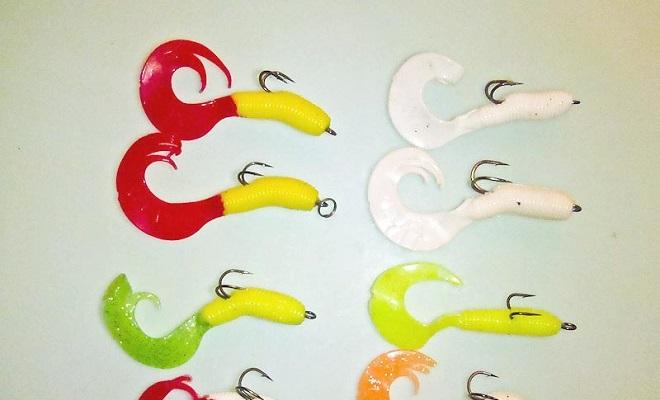
Important! A deformed bait has a noticeably more negative effect on the quality of its play when fishing.
In most cases, deformations of the silicone bait arise from an incorrectly determined puncture site and from an incorrectly selected length of the shank of the vibrotail hook. In case of sluggish bite, uncertain bites and frequent gatherings, it is reasonable to equip the bait with a jig using a tee in the installation. This installation option allows you to increase the chances of catching a cautious and fastidious predator.
Retractable leash
This equipment appeared for two reasons. Firstly, due to the need to cast light bait far.
And secondly, because of the need for a smooth presentation of this bait to the fish. This equipment also allows you to keep the playing bait in the biting zone for as long as possible, especially in the current, which is very good for seducing passive fish.
But there are several conditions, non-compliance with which can and will certainly lead to negative consequences.
- The length of the leash must be at least a meter. You can even identify a certain pattern: the slower the current and the more passive the fish, the longer the leash should be.
- The bait on the line should not rotate around its own axis. The absence of rotation is achieved by selecting the weight of the offset hook, or by additional loading using a float pellet. But this applies to a greater extent to twisters, and creatures and vibrating tails rarely need such adjustment.
- Do not throw against the wind or upstream. As a result, the leash wraps around the main line and the wiring turns out to be empty. But, if the conditions are such that there is no other way to cast against the wind, then the cast in this case should be as smooth as possible.
Diversion baits can be either active or passive. At the same time, passive ones sometimes work better.
Plus, on short and smooth jerks, the driven passive bait darts left and right in a very interesting way. It is especially good to achieve this behavior from the Sexy Impact slug from Keitech or its budget analogue from Kosadaka – Sota worm.
They are both made according to the same principle - casting in two stages. Thus, a floating back is obtained (due to the greater amount of salt in the composition) and the bait does not twist.
Tee equipment
To equip vibrotails with triple hooks, you will need additional unpretentious equipment in the form of a metal or plastic tube with a diameter of no more than five millimeters. The length is enough to be 2 cm. The tube should be one and a half times the thickness of the silicone bait being mounted. This device is needed to make a through hole in the side of the vibrating tail body for mounting a tee.
Important! The hole should be optimal in diameter based on the size of the tee. A small hole will not allow symmetrical installation of the tee hooks, and a large hole will increase the play of the tee during wiring and will deteriorate the quality of the nozzle’s play.
As in the first installation diagrams, markings are made to determine the point of the required hole. The length of the forend of the tee, excluding the loop for fastening, will be our main guideline. We pierce the vibrating tail with a previously prepared tube, since silicone is a pliable material for these manipulations. Next, in the hole made towards the mouth of the fish inside the body of the bait, we thread the triple hook through the front with a fastening ring. Stretching the hole previously made with a tube, we transfer the first tip of the tee to the opposite side of the artificial fish.
We pierce the back with the second sting through the same hole, bringing the tip parallel to the back of the silicone, and leave the third hook without any manipulation. In principle, the installation of the vibrating tail on the tee can be considered complete. The disadvantages of this installation are its rather low cross-country ability in fishing areas with vegetation. The best option for using silicone baits on tees is in clean areas of the reservoir.
Caroline and Tirette
The essence of the equipment is that a load in the shape of an olive or a bullet moves freely along the main line. And to the end of the main line, a leash up to 60 centimeters long is tied through a swivel, to which the bait is attached.
Initially, this equipment was designed for bass fishing, but our fish also liked it. Primarily zander and perch.
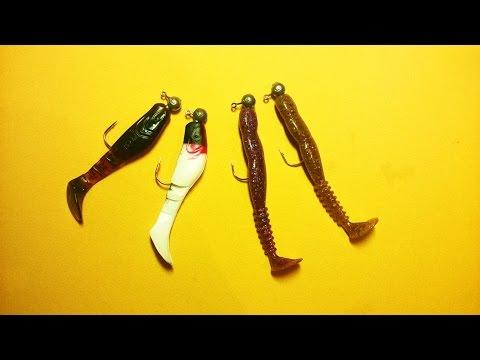
Another element of the equipment is glass or plastic beads between the sinker and the swivel. Americans explain their necessity by saying that when tapped, they produce a sound similar to the one a crayfish makes when molting.
In general, this version seems far-fetched, since the number of bites did not differ in the case of installation without beads. The only more or less plausible version seems to be the one where it is said that the beads protect the knot from deformation under the influence of an impacting load.
The equipment is exclusively bottom and the main wiring is slow drawing with pauses. Thanks to the shape of the load, it passes obstacles well, and therefore is suitable for fishing among scattered stones and large debris.
The importance of equipping a vibrotail when fishing
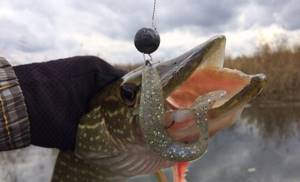
The ability to correctly, competently and effectively equip vibrotails with various types of hooks allows you to use broader strategies when catching a predator. After all, these types of equipment, excluding only the attachment of a vibrotail on solid jig heads, make it possible to use silicone baits in combination with replaceable articulated weights, so-called Cheburashkas among fishermen, as well as when fishing with a bombard under various fishing conditions. Equipping the vibrating tail with an offset hook, double and tee can be safely called universal. After all, by manipulating the load of the Cheburashka and the float of the bombard by type and weight, the bait can be used at different depths and at the same time perform different types of postings.
Well, by changing the types of hooks, you can successfully catch them in overgrown and snagged areas of the reservoir and when the predator is passive. Therefore, the arsenal of fishing lures for those who like to catch predators representing freshwater bodies of water should include all the types of installation discussed above. After all, equipment prepared at home will save valuable time on fishing and increase the fisherman’s chances of a successful fishing outcome, even despite the prevailing conditions of the fishing session.
Difference in Shape
Jig heads can come in a wide variety of shapes. Their names largely explain their appearance:
- ball;
- rugby (ball);
- "digger";
- fish head;
- bullet;
- spoon;
- ski;
- boot;
- banana;
- Vanka-Vstanka;
- horseshoe.
The head weight can be made without a hook. Then a hinge joint is used to connect the sinker and the hook. Individual heads are manufactured in three types:
- eared sinker (“Cheburashka”);
- lentils.
Despite the variety of jig head shapes, the main parameter when selecting is weight. It is the weight of the sinker and bait that determines the horizon of the rig’s passage.
For fishing in standing and shallow reservoirs, heads weighing 1-15 g are used. For river fishing, as well as in reservoirs with great depths (more than 5 m), jig heads weighing up to 40 g are required.
We suggest you read: How to choose the best spinning rod for jig: parameters, types, budget options
